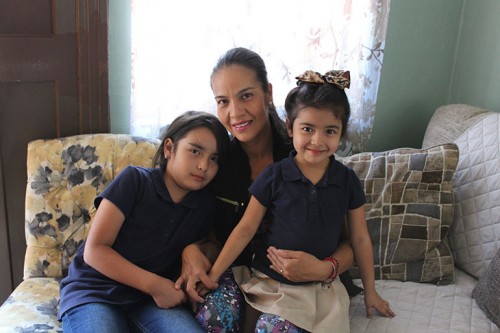
Eight-year-old Erika Andalon, left, is again receiving dental care since a state law allows children living in California without papers to enroll in the state’s public health program. She is pictured with her sister Elaine, 4, and mother, Erika, in their Los Angeles home. (Ana B. Ibarra/California Healthline)
Eight-year-old Erika Andalon recently started treatment for six cavities at an AltaMed dental clinic in eastern Los Angeles near her home. She hadn’t been to a dentist for more than a year. Yet her younger sister, Elaine, has visited the dentist regularly since she was six months old.
The difference? Access to coverage.
Erika was brought to the U.S. from Jalisco, Mexico, five years ago. Elaine, on the other hand, was born in California, which makes her a U.S. citizen. Because of her citizenship status, and because of her family’s low income, she always has received full benefits under Medi-Cal, the state’s version of Medicaid.
Since May 1, a new law (SB 75) has given Erika and other children living in the United States without legal immigration papers full access to Medi-Cal benefits, including dental services.
Now Erika gets the same benefits as her little sister — including dental care.
“It’s been a huge relief,” Erika’s mother, also named Erika, said Wednesday. “Elaine goes to the dentist twice a year, now we can do the same with [Erika].”
Young Erika is one of almost 138,000 undocumented children in California who have gained Medi-Cal coverage under the so-called “Health for All Kids” law, which provides health care for all California children regardless of their immigration status.
Dental coverage under the state’s Denti-Cal program is included in the expanded benefits, and there is widespread hope that it will improve pediatric oral care in California. But delivering on that promise could be a stiff challenge for a program in which more than half of children who were covered before the law took effect had not seen a dentist in the previous year.
The lack of access has created an “epidemic of tooth disease in which toddlers by the thousands have mouthfuls of cavities,” according to a searing report by the Little Hoover Commission, an independent oversight agency, released earlier this year. A big reason for Denti-Cal’s dysfunction, the report said, are low reimbursement rates that have “thoroughly alienated the dental profession.”
The head of Denti-Cal, Alani Jackson, told California Healthline earlier this year that newly enrolled children should have no problem getting an appointment with a dentist.
But dental professionals said this week that it is still too early to tell how the program will stand up to the new stress of the additional beneficiaries.
Before the new law took effect four months ago, immigrant children qualified only for “emergency” Medi-Cal, which gave them coverage for emergency room care. Some qualified for county-level health programs that did not tap Medi-Cal funding.
Erika Andalon’s mom relied heavily on free dental exams offered at school to get baseline dental care for her older daughter.
“But we had no idea” about the six cavities, she said. “It wasn’t until she got a proper exam with dental X-rays that we learned about the problem.”
As more children enroll in Medi-Cal and Denti-Cal as a result of the new law, dental offices and clinics are beginning to see more young patients like Erika.
Dr. Rosa Arzu, the dental director at AltaMed, a network of clinics in Los Angeles and Orange counties, said the 24-clinic group has extended hours for patients, including opening on Saturdays.
While the clinics are not tracking the number of new immigrant children needing care, Arzu said the dentists at AltaMed have noted that previously uninsured kids who had not visited in years are now in need of more intensive care.
AltaMed dentists already had seen many of the children before they qualified for Medi-Cal, because of the clinics’ “sliding fee” – a payment option in which the cost of services depends on the family’s income.
“But even though this payment was low, many families were struggling, so they delayed treatment,” Arzu said. Some patients still don’t realize that dental services are included in their newly insured children’s benefits, she said.
While all eyes are on the new law, it might be too early to gauge its impact, said Dr. Roseann Mulligan, associate dean of Community Health Programs and Hospital Affairs at the University of Southern California’s dental school.
There are still a few “wrinkles,” and newly enrolled families are still figuring out the system, Mulligan said.
As members of the USC dental school’s Children’s Health and Maintenance Program (CHAMP), Mulligan and other staff visit Head Start child care centers and WIC nutrition offices, where they provide screenings and refer families to nearby dentists.
At those locations, CHAMP staff members have met families who are not aware they are enrolled in an HMO dental plan and therefore can only see certain dentists. If they want a specific dentist, or more options, they must enroll in a fee-for-service plan, and that can take more time, Mulligan explained.
Another 64,500 immigrant children are expected to sign up for full Medi-Cal and Denti-Cal benefits within the next year.













